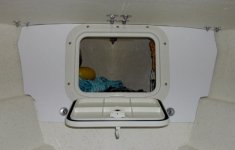Hayesie Daze
Member
- Joined
- Jun 2, 2008
- Messages
- 32
- Reaction score
- 0
- C Dory Year
- 2007
- C Dory Model
- 22 Cruiser
- Vessel Name
- Hayesie Daze
Hello,
I was looking for some recommendations, solutions, etc. on how to close the exposed anchor area off in the v-berth. I would like to fabricate (or at least try to as painful as it may be) something like you see in the 25 cruiser with a hatch to access the chain/line. Thanks in advance.
Byron
I was looking for some recommendations, solutions, etc. on how to close the exposed anchor area off in the v-berth. I would like to fabricate (or at least try to as painful as it may be) something like you see in the 25 cruiser with a hatch to access the chain/line. Thanks in advance.
Byron




